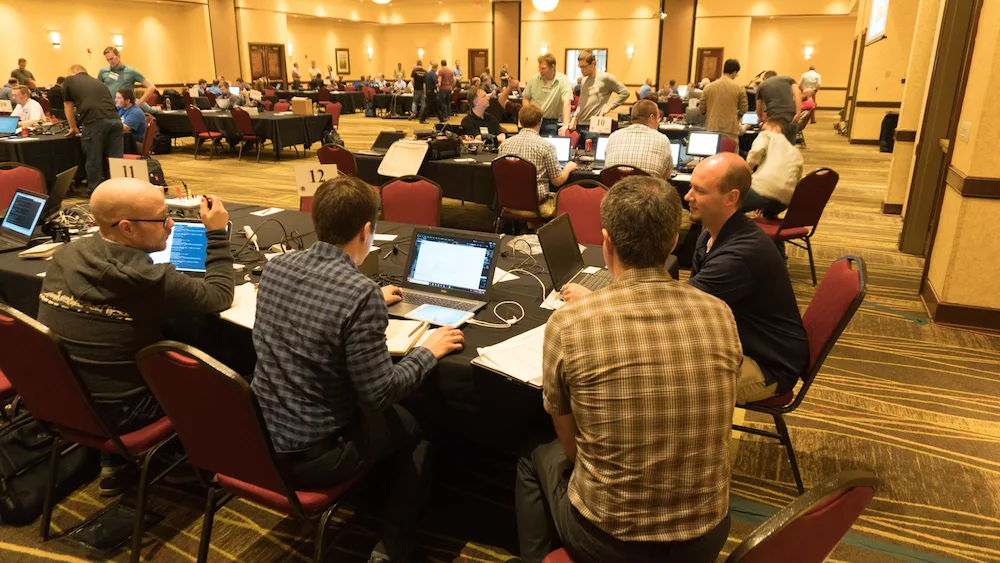The spring Plugfest event in Lincoln, Neb., May 14-18, was the first of two annual opportunities put together by the Agricultural Electronics Foundation (AEF) for ag equipment engineers to test a series of displays and installations for ISOBUS compatibility.
Groups of developers collaborated in 30-minute windows, allowing each side to test the functionality of their platform against another. The variety of pairings is a key component of the development stage for manufacturers, as it helps them to detect and tend to any bugs or underlying issues in their software.
Rotating stations to observe the testing and talking with engineers during the event, here are the top 3 takeaways from Precision Farming Dealer.
1. Pushing the Path to ISOBUS Certification
Once a platform reaches the end of the development phase, companies take it to an accredited test lab to receive AEF certification and admittance into a growing AEF database of ISOBUS certified devices. Certification is determined through a conformance tool developed by AEF, testing a series of components relative to their unified ISOBUS standard, including messages, functionality speed and more.
As described by Benjamin Jefferson, vice president of business development for DISTek Integration and member of the AEF communication and marketing team, the certification database is available online and also as an app for farmers, dealers and developers to see which devices are compatible with different equipment.
“You can search for functionalities such as section control or rate control,” Jefferson says. “It shows not only individual pieces of equipment, but also combinations of equipment and how those combinations work together when they would be plugged in an actual tractor implement combination.”
2. Streaming Toward High-Speed ISOBUS
Among the most interesting aspects of Plugfest is the collaborative nature of the event, requiring competitors to set aside their differences and work towards the collective goal of universal compatibility across ag equipment.
“Even if it’s a John Deere tractor pulling my implement, I want it to work the best that it can,” says AGCO software engineer Mike Schmidt on developers working together before heading back home to compete. “Of course, if he's pulling his AGCO implement with his AGCO tractor, we might be able to provide some extra features, but I want the user interface and interaction between them to be seamless so that we’re not getting calls about why doesn't this work.”
Key to that seamless integration are fewer manual steps connecting equipment and fewer support calls from the field, says Dave Smart, team leader for AEF’s High Speed ISOBUS project. Current platforms use CAN-based ISOBUS connectivity, which Smart notes is limited from a speed and bandwidth perspective.
Those limitations serve as the groundwork for AEF’s High-Speed ISOBUS project, which will be designed for faster data exchanges through a wider and more capable bandwidth. Once developed, Smart says farmers will be able to log and apply data more accurately to improve the efficiency of machines.
“With High-Speed ISOBUS on a planter, we will have the bandwidth to actually get down to row-level and see what each row is doing,” he says. “From there, I can determine if I actually need to have a prescription that can adjust row-by-row. With CAN, it’s too constraining. With high-speed, I’ll be able to use analytics and create another control to reduce chemical application and save money.”
3. Improving Data Standards & Seed Traceability
A conference day was implemented into PlugFest, allowing for a series of presentations about compatibility projects across the industry. Among the presenters was Joe Tevis, senior consultant for Topcon Precision Ag, who discussed the Ag Gateway seed connectivity project.
As the focus for farmers expands beyond the creation of yield maps and applied data, Tevis says the project is designed to help farmers manage their seed data by simplifying the varying standards for how that data can be received and exchanged.
“We’ve started to look at our traceability working group and seed identity preservation, which means accurately recording the seed right as it gets loaded into the planter,” he says. “This allows us to capture data that’s not available to us in the planting process, including batch numbers and load IDs.”
By capturing that data in real-time, Tevis says the project team can work with inventory managers to define barcode standards within a seed warehouse and improve compatibility between both parties, allowing farmers to accurately document the planting process from start to finish.
By fully documenting planting processes in the future and automating seeds as they load into the planter, Tevis says manufacturers, farmers and dealers will be better prepared for changes in planting plans.
“Most OEM manufacturers support the process of documenting what variety is being planted,” Tevis says. “The problem with that is those plans often change by the time they get to the field. Either the variety runs out, weather conditions dictate the planting of another variety, or they may have a requirement with the seed provider to send them the as-planted data, for which they want the lot numbers also on the seed bag.
“Those lot numbers typically are not available at planting time. It’s a real-time situation where you load the variety that you get, and the lot number for that bag is on the ticket.”




![[Technology Corner] Autonomy & Robotics Take Center Stage](https://www.precisionfarmingdealer.com/ext/resources/2026/01/12/Autonomy--Robotics-Take-Center-Stage.webp?height=290&t=1768253759&width=400)


